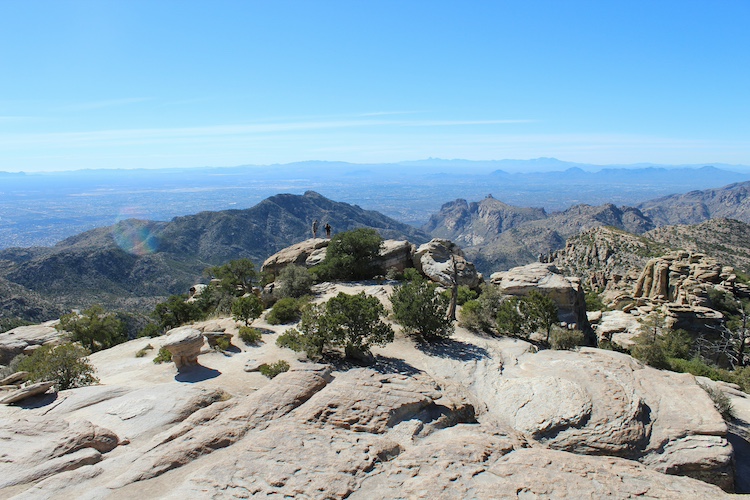We always imagine a holiday as something that should happen far away. We want to cross the ocean or a continent to a place with different trees, different people, different things. That novelty and transformation pulls our attention back to the world around us before everything becomes too much the same. Yet the world is very big and new places hard to reach, so when you can experience several unfamiliar landscapes in a single, short journey, you’ve discovered something special.
From my home in Tucson, Arizona, in the heart of the Sonoran Desert, there is just such a place. It’s called a sky island, and this particular one is part of the Santa Catalina Mountains. On it, I can experience almost the entire North American landscape in a single bike ride.
Sky island describes these kinds of mountains perfectly. They are massive peaks scattered across the desert floor. Separated by miles of cacti and roaring sun, each mountain is an isolated habitat with its own microclimate and unique ecosystems. In fact, their seclusion means that many species can only be found on a single sky island because the next suitable habitat lies beyond a sea of desert. But their isolation isn’t the only thing that makes them unique.

As a rule of thumb, for every 1,000 feet of elevation you gain, the temperature drops around five degrees, the equivalent of driving 300 miles north, and the landscape transforms accordingly. So, to travel through multiple North American biomes, I could change my latitude and go there physically, or I could simply change my altitude and stay right here in Arizona.
I do just that often — especially on my bicycle. On an early Saturday morning, I’ll leave the city and pedal slowly through Tucson’s extensive cycle network, which includes a 100-plus-mile bike path which encircles the entire city. I’ll begin my ride with a broad sweep around the southeast toward the summit of Mount Lemmon, more than 9,000 feet in the air. I’ll bring a few things to eat, plenty of water, and an audiobook.
The road that takes me to the top is the Catalina Highway. It’s everything that makes America great: a wide and smooth ribbon of asphalt stretching from the desert floor up into the forest. Its 27 miles lift you almost 7,000 feet — the equivalent of traveling from Tucson to Banff, Canada. Scattered on both sides of the road lie several picnic spots, many hiking trails, a small lake, and several campgrounds. Together, they create ideal conditions for outdoor adventures — especially an overnight bicycle tour. (Or for a longer trip, you could string together an island-hopping ride among any or all of the 16 sky islands spread across southern Arizona’s Coronado National Forest.) All of this is spread across five distinct habitats created by the elevation change.
Through the noisy city appears the Lower Sonoran Desert, famed for its saguaro cacti. Then follows the Upper Sonoran Desert shrublands, the desert grasslands, the chaparral and oak woodlands, and finally — past the pinyon, junipers, and ponderosa pines — the mixed conifer forest complete with lingering winter snow and a few roaming bears. The bicycle is the best method to witness this natural transformation firsthand. That way, I can personally greet the last saguaro and appreciate every habitat in detail. I can also stop wherever I like, taking in the views while my body catches its breath.
To round off the Catalina Highway, there is a little wooden cabin at the very top that serves an enormous, freshly baked cookie and hot coffee. You’ll have earned them. Outside, the wind whistles through the conifer needles, and the entire experience is literally a world away from what’s happening down in the desert. But the best reason to take such a trip by bike is the downhill you get at the end of your ride — all 30 miles of it. Then you can experience the transformation again, this time in reverse and a little bit faster. The green trees turn into brown trees, then shrubs, then grasslands, and later the first saguaro cactus waving its arms in the air. Then, it’s back to the city, another two hours of backstreets, and finally home.
Arizona’s sky islands may offer ideal conditions to experience this natural phenomenon of elevation, but they’re not the only place. It can be observed all over the world, including in the Southern Hemisphere, where climbing 1,000 feet provides the same transformation as travelling 300 miles south. Thus, in certain aspects, we can compare the climate of South Africa’s Drakensberg at a particular elevation to that of Cape Town.
What binds it all together is the incredible biodiversity our planet offers — not only when we set off on grand journeys, but also, sometimes, right in our own backyard.
To read more of Stefan’s writing, visit his blog at adailyrumble.com
The post An Ode to Bicycling Arizona’s Sky Island appeared first on Adventure Cycling Association.




